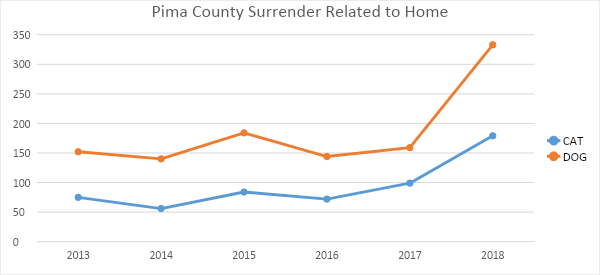Housing crises exist all over the United States: from the Bay Area of California to the gulf coast of Florida. While the East coast experiences higher eviction rates, the West coast has more people experiencing homelessness. The lack of housing for people, coupled with the ability for property owners and managers to limit pets, increases the likelihood of pets entering the shelter. Traditionally, we have said, “This is a people issue, what can animal services do?” Here are seven things you can do to take care of both ends of the leash.
1. Develop Partnerships
City leaders all over the country are working alongside nonprofits and social welfare groups to address the housing crisis issue and the huge population of families affected. Universities and nonprofits are developing digital advocacy tools, websites that write letters from the tenant to the landlord for a variety of situations, and resources for legal assistance, financial aid, relocation, and more. Eviction directly correlates to homelessness and emergency services. Find the organizations that are already working within this segment of your community, and ask to participate.

Photo above: In Tucson, pet owners facing homelessness can get pet supplies at outreach events.
2. Pet Friendly Housing
The ASPCA conducted a survey of individuals who had given away a pet, and found that about two percent said access to pet friendly housing would have helped them keep their pet. If your team can provide a list of pet friendly housing within your community, share it far and wide. Find ways to promote and benefit property owners and managers that value our furry family members.
3. Offer Pet Deposit Assistance
When a pet owner has to move into a new place, there is the burden of security and cleaning deposits, along with the expense of relocating. Often times, the initial pet deposit is the additional expense that can be avoided. Whether you find a way to give the funds away or arrange a repayment schedule with housing in your community that requires deposits, providing $200-$500 one time far outweighs the daily sheltering expense.
4. Offer Temporary Boarding
Many times people who are transitioning between housing are in need of two weeks of animal care; they may have a couch at a friend’s but can’t bring their pet, or are staying in transitional housing where pets aren’t allowed. Team up with organizations that provide housing in order to create pet friendly emergency and transitional housing. Work with a local pet boarding company to provide discounted or free care for a short period of time. Knowing that a pet will be reunited with their owner in two weeks sure beats housing that animal in the shelter for a month or longer.
5. Collect The Data
Shelters with government contracts typically use an intake type and subtype like confiscate:eviction to indicate when they are called to a property to impound animals because the owner has been evicted and abandoned one or more pets, or because the tenant is in the final step of being evicted and has no option for their pet. Additionally, all shelters that take owner surrenders should track reasons for surrender, and many of them are related to housing problems: landlord, new lease, moving, lost home, size.
6. Report Your Data
Historically animals are left out of the housing analysis. Ask anyone working in social or animal welfare though, and they will tell you that pets not only play a part in decreasing options for these families, but also have community wide financial ramifications. But this information is NOT collected and shared. Your housing authority or commission needs to understand the direct effect to your municipality of lack of pet friendly housing, and it is your responsibility to get into the discussion.

Photo above: PACC housing related surrenders more than doubled in 2018.
7. Discuss The Economic Impact
Some reports state that it costs a community $30,000 a year to provide emergency shelter to one person, while it costs an average of just $2,000 to keep them in their home. By providing resources, educational tools, and support, the cost to taxpayers is decreased by about $28,000 per recipient. Similarly, the cost to house a pet in a municipal shelter is estimated to be about $800, while studies show the cost to keep a pet in the home is closer to $200.
Evictions and affordable housing shortages are a complex systems issue. Work is being done all over the country to understand the upstream causes and the downstream effects. There is still much work to be done, and the direction of that work depends greatly on improving the data collection process throughout the nation in order to give pets a voice in this matter.
If you represent an organization that collects, or influences the collection of, data related to housing in any manner, I urge you to push to have pet measurements added. This will not only help us help pet owners, but decrease the gaps in social services.